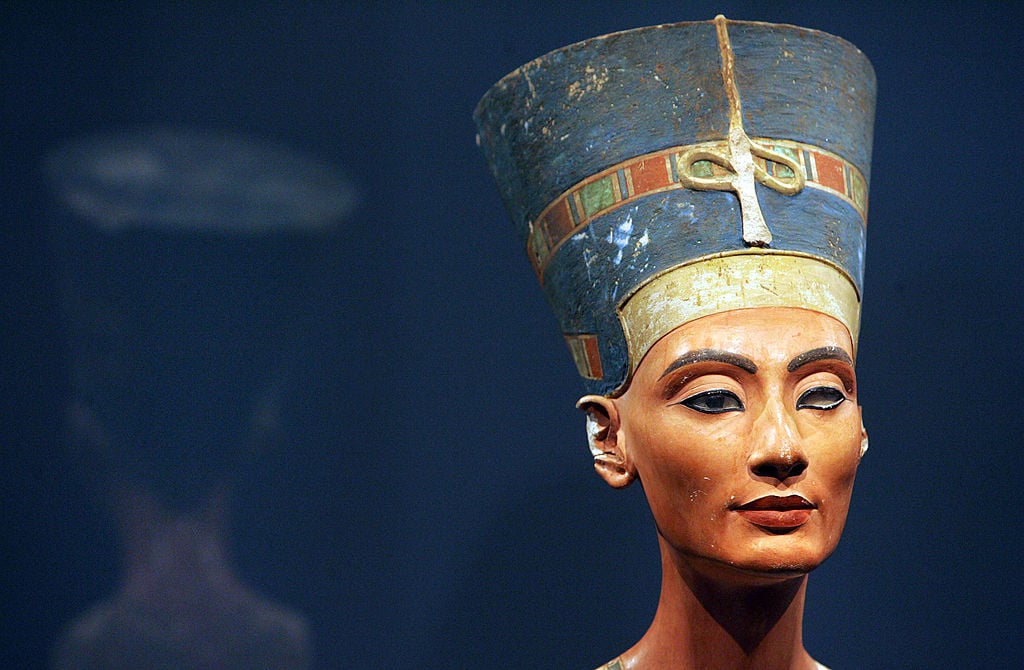
Celebrity archaeologists perennially announce that they’re close to unearthing the tomb of Nefertiti, perhaps ancient Egypt’s most powerful queen. She first tantalized the modern world with her beauty alone in 1912, when her iconic bust appeared. Her importance in ancient Egypt became better known over the following years. Still, archaeologists remain baffled about her abrupt disappearance from the historical record—and where her remains lie.
Nefertiti was raised at the court of Thebes, and may have been the daughter of Ay, a vizier to Amenhotep III. She married Amenhotep IV, heir to the throne, at age 15. Polytheistic ancient Egyptians each favored one god or another. Nefertiti followed Aten, the sun god. In either the fifth or ninth year of his reign, Amenhotep III changed his name to Akhenaten and devoted Egypt to an unpopular monotheism around Aten. Nefertiti changed her name too, to Neferneferuaten.
Many scholars believe Nefertiti wasn’t a queen, but a co-regent. Carvings portray her smiting Egypt’s enemies. After bearing Akhenaten six daughters, Akenhaten’s sister bore him King Tutankhamun. Fourteen years into his reign, one of Nefertiti’s daughters died in childbirth. Shortly after, Nefertiti vanishes from the record.
A house altar relief depicting Akhenaten, Nefertiti and three of their daughters (ca. 1350). Photo by: Prisma/Universal Images Group via Getty Images.
Most historians think she died, but other theories have proliferated. Some posit that Akhenaten ditched her for not producing an heir, but he had King Tut by then. Another debunked theory said she was banished for defecting from Aten. Yet another says Nefertiti committed suicide after her daughter’s death.
More recently, researchers have wondered whether Nefertiti was the mysterious “dakhamunzu” (possibly a rendering of the words for “Egyptian queen” in the language of the Hittite people) who begged, in a letter known from historical records, to wed the son of a Hittite king. Far more researchers, however, believe she became monarch herself after Akhenaten’s death. Zahi Hawass, one of the celebrity archaeologists on the case, thinks Nefertiti dressed as a man named Smenkhkare to rule until King Tut could take over.
Zahi Hawass with a bust of Nefertiti at the Neues Museum Berlin in 2009. Photo: Patrick Chapuis/Gamma-Rapho via Getty Images.
Nefertiti’s mummy would offer clarity. In 2003, British Egyptologist Joann Fletcher finally got Hawass—then heading Egypt’s Supreme Council of Antiquities—to sanction her study of three mummies from the tomb of Amenhotep II. Fletcher announced on the Discovery Channel that one was Nefertiti, but a group of Egyptologists countered her conclusion. In 2007, National Geographic brought a CT scanner to Egypt so Hawass could test his own hypothesis that one of the other two mummies was Nefertiti. Neither was.
Hawass remains a leading name in the search for Nerfertiti alongside British archaeologist Nicholas Reeves, who announced in 2015 that high-resolution surface scans had found hidden doors in King Tut’s tomb, potentially leading to Nefertiti. Archaeologists under another former Egyptian minister of antiquities, Mamdouh Eldamaty, overcame significant doubt to confirm the presence of hidden rooms using ground-penetrating radar technology in 2020.
In 2022, Hawass announced that freshly discovered amulets belonging to King Tut corroborated his guess that one of two mummies he’d unearthed elsewhere in the Valley of the Kings had to be Nefertiti. Reeves announced 11 days later that hieroglyphs he’d found on King Tut’s tomb further evidenced Nefertiti’s burial there. Both parties have stayed quiet in the years since, though Hawass said in 2023 that Nefertiti’s decisive identification is coming this year.
The Hunt explores art and ancient relics that are—alas!—lost to time. From the Ark of the Covenant to Cleopatra’s tomb, these legendary treasures have long captured the imaginations of historians and archaeologists, even if they remain buried under layers of sand, stone, and history.